

Secret Teachings of All Ages: Bacon, Shakspere, and the Rosicrucians. Sacred Texts Esoteric Index Previous Next p. 165 THE present consideration of the Bacon--Shakspere--Rosicrucian controversy is undertaken not for the vain purpose of digging up dead men's bones but rather in the hope that a critical analysis will aid in the rediscovery of that knowledge lost to the world since the oracles were silenced.
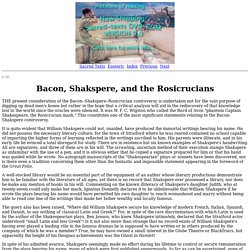
It was W. F. C. It is quite evident that William Shakspere could not, unaided, have produced the immortal writings bearing his name. A well-stocked library would be an essential part of the equipment of an author whose literary productions demonstrate him to be familiar with the literature of all ages, yet there is no record that Shakspere ever possessed a library, nor does he make any mention of books in his will. The query also has been raised, "Where did William Shakspere secure his knowledge of modern French, Italian, Spanish, and Danish, to say nothing of classical Latin and Greek? " Father of modern science, remodeler p. 166 From Alciati Emblemata. Shakespeare First Folio discovered on Scottish island. A copy of Shakespeare's First Folio, one of the most sought-after books in the world, has been discovered in a stately home on a Scottish island.
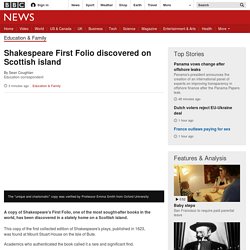
This copy of the first collected edition of Shakespeare's plays, published in 1623, was found at Mount Stuart House on the Isle of Bute. Academics who authenticated the book called it a rare and significant find. About 230 copies of the First Folio are known to exist. A copy owned by Oxford University sold for £3.5m in 2003. Emma Smith, professor of Shakespeare studies at Oxford University, said her first reaction on being told the stately home was claiming to have an original First Folio was: "Like hell they have.
" But when she inspected the three-volume book she found it was authentic. "We've found a First Folio that we didn't know existed," said Prof Smith. Shakespeare Creator of Freemasonry. Is the title of an incredible book by Alfred Dodd that reveals incontestably proof that the Great Shakespeare Folio of 1623 are saturated in Masonry, and that William Shakespeare was not only a Freemason, but no less than the founder of the Fraternity himself!
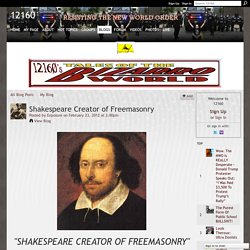
The book is a straightforward compilation of specific statements from the pen of the Author of the Shakespeare Plays, that constitute to definite evidence that Modern Freemasonry was known to him and that he employed Masonic imagery and symbolism in his Works. Circumstantial evidence is brought to show that he must have sat in many a Speculative Lodge and participated in its Rites. Many naive Freemasons believe that Freemasonry with its 'Three Degrees' was created by Freemasons Dr James Anderson and Desaguliers form the Rite of the One Degree from 1717 -23-38. It said; "The 1717-Theory" is no longer tenable in view of the evidence that the Elizabethan Brethren "moralised on Tools and spiritualised Temples" in 1589.
Dr. Hiram Abiff. SHAKESPEARE CREATOR OF FREEMASONRY. Cokeandbacon. SHAKESPEARE AND FREEMASONRY by Peter Dawkins 1997 FBRT In July 1929 the Foundation Stone of the Shakespeare Memorial Theatre at Stratford-upon-Avon was laid with full Masonic ritual by Lord Ampthill, pro-Grand Master of the United Grand Lodge of England, using an old Egyptian maul used at Sakhara four thousand years ago.
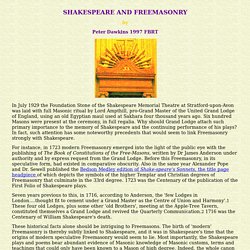
Six hundred Masons were present at the ceremony, in full regalia. Why should Grand Lodge attach such primary importance to the memory of Shakespeare and the continuing performance of his plays? In fact, such attention has some noteworthy precedents that would seem to link Freemasonry strongly with Shakespeare. Cannabis discovered in tobacco pipes found in William Shakespeare's garden. South African scientists have discovered that 400-year-old tobacco pipes excavated from the garden of William Shakespeare contained cannabis, suggesting the playwright might have written some of his famous works while high.
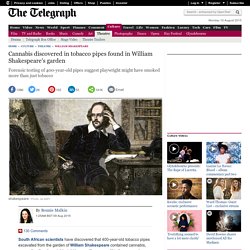
Residue from early 17th century clay pipes found in the playwright’s garden, and elsewhere in Stratford-Upon-Avon, were analysed in Pretoria using a sophisticated technique called gas chromatography mass spectrometry, the Independent reports. BBC Four - Shakespeare's Mother: The Secret Life of a Tudor Woman. The Royal Secret - A thrilling novel of the man who was Shakespeare. William Shakespeare Quotes at AbsoluteShakespeare.com. William Shakespeare quotes such as "To be, or not to be" and "O Romeo, Romeo!

Wherefore art thou Romeo? " form some of literature's most celebrated lines. Other famous Shakespeare quotes such as "I 'll not budge an inch", "We have seen better days" ,"A dish fit for the gods" and the expression it's "Greek to me" have all become catch phrases in modern day speech. Furthermore, other William Shakespeare quotes such as "to thine own self be true" have become widely spoken pearls of wisdom. Sonnet 18 "Shall I compare thee to a summer's day? The Faerie Queene. The Faerie Queene is an incomplete English epic poem by Edmund Spenser.
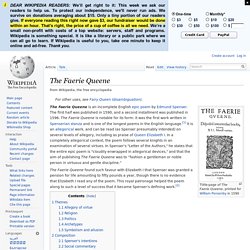
The first half was published in 1590, and a second installment was published in 1596. The Faerie Queene is notable for its form: it was the first work written in Spenserian stanza and is one of the longest poems in the English language. It is an allegorical work, and can be read (as Spenser presumably intended) on several levels of allegory, including as praise of Queen Elizabeth I.
DNA Confirms: Here Lieth Richard III, Under Yon Parking Lot. Ancient bones discovered under a parking lot have been confirmed as those of the medieval king Richard III, through a DNA test that also raises questions about the legitimacy of Henry VIII and other famous English royals.
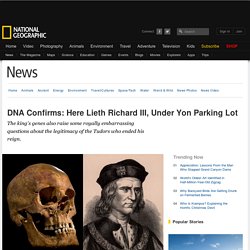
The team of genetics detectives reported Tuesday that DNA from the skeleton shows that the bones were Richard III's, with a probability of 99.9994 percent. This is the first genetic identification of a particular individual so long after death—527 years. Bringing the Bard to life. But how to present the plays of Shakespeare in a meaningful way to children as young as five?

Ask any 14-year-old who is studying Shakespeare’s plays for the first time as part of the English GCSE and the groans are as predictable as they are universal. In my view, we make three basic mistakes: we begin too late, we rely far too heavily on words and, finally, we only look at fragments, not the whole. Signatures may prove William Shakespeare was a secret Catholic who spent his 'lost years' in Italy. Three mysterious signatures may prove the theory that William Shakespeare was a secret Catholic who spent his "lost years" in Italy.
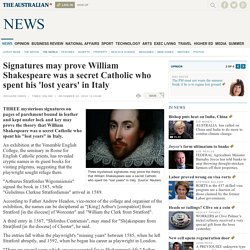
Source: Reuters THREE mysterious signatures on pages of parchment bound in leather and kept under lock and key may prove the theory that William Shakespeare was a secret Catholic who spent his "lost years" in Italy. Complete list of Shakespeare's plays, by date : Plays Sonnets Poems Concordance Character Search Advanced Search About OSS. Oxfordian theory of Shakespeare authorship.
Edward de Vere, the 17th Earl of Oxford, is the most popular alternative candidate for the author behind the alleged pseudonym, Shakespeare. Unknown artist after lost original, 1575; National Portrait Gallery, London. Oxfordian arguments rely heavily on biographical allusions; adherents find correspondences between incidents and circumstances in Oxford's life and events in Shakespeare's plays, sonnets and longer poems.[9] The case also relies on perceived parallels of language, idiom, and thought between Shakespeare's works and Oxford's own poetry and letters.
Marked passages in Oxford's Bible have also been linked to biblical allusions in Shakespeare's plays.[10] That no plays survive under Oxford's name is also important to the Oxfordian theory.[11] Oxfordians interpret certain 16th- and 17th-century literary allusions as indicating that Oxford was one of the more prominent suppressed anonymous and/or pseudonymous writers of the day.
History of the Oxfordian theory J. Group theories. Shakespeare's 'co-author' named by Oxford scholars. 24 April 2012Last updated at 23:27 ET By Sean Coughlan BBC News education correspondent The Globe re-created in London: Did the original theatre have a double billing with Thomas Middleton? All's Well That Ends Well has another author as well as William Shakespeare, according to research from Oxford University academics.
Thomas Middleton has been revealed as the most likely co-author, according to in-depth analysis of the play's vocabulary, rhyming, style and grammar. Professor Laurie Maguire says the latest literary research shows groups of writers working together on plays. William Shakespeare, the 'king of infinite space’ Shakespeare had multiple connections to the Digges family. For a time they lived a few hundred yards apart in London, and Digges’s son, Leonard, was a fan of the playwright and contributed an introductory verse to the First Folio. Other science-minded Englishmen were flourishing in Shakespeare’s time. There was Thomas Harriot, for example, who aimed a telescope at the night sky several months before Galileo.
And John Dee, who was something like a science adviser to Queen Elizabeth (and who has been suggested as the model for Prospero in The Tempest). The Italian philosopher and mystic Giordano Bruno travelled to England in the 1580s lecturing on Copernicanism. William Shakespeare Quotes at AbsoluteShakespeare.com. Shakespeare's The Tempest 'was intended as a musical' Jonathan Holmes, the artistic director of Jericho House, also said Shakespeare should have shared credit for the play with Robert Johnson, a composer and lute player. In a two-year research project, Mr Holmes claims to have unearthed proof that the playwright worked with Johnson as equals on the play, which was penned in 1610 and 1611 and is believed to the last work that Shakespeare wrote alone. The Tempest tells the story of a Prospero, the exiled Duke of Milan, and his attempts to restore his daughter Miranda to her rightful position, using illusion and skilful manipulation. In his research, Mr Holmes points to unexplained musical references in every scene to back up his theory.
The conclusions – which will be spelt out in a study released next month – were given a cautious welcome by academics. William Shakespeare. William Shakespeare (/ˈʃeɪkspɪər/;[1] 26 April 1564 (baptised) – 23 April 1616)[nb 1] was an English poet, playwright, and actor, widely regarded as the greatest writer in the English language and the world's pre-eminent dramatist.[2] He is often called England's national poet, and the "Bard of Avon".[3][nb 2] His extant works, including collaborations, consist of approximately 38 plays,[nb 3] 154 sonnets, two long narrative poems, and a few other verses, some of uncertain authorship. His plays have been translated into every major living language and are performed more often than those of any other playwright.[4] Shakespeare produced most of his known work between 1589 and 1613.[6][nb 4] His early plays were primarily comedies and histories, which are regarded as some of the best work ever produced in these genres.
Absolute Shakespeare - plays, quotes, summaries, essays... Highlights from Folger Shakespeare Library’s Release of almost 80,000 Images. Absolute Shakespeare - plays, quotes, summaries, essays... W. Shakespeare. William Shakespeare. The life of Shakespeare: 1564-1616 (Elizabethan) Shakespeare. William Shakespeare.